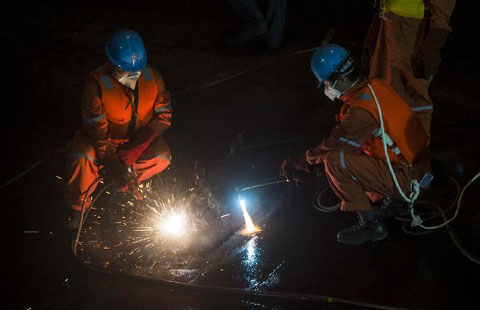Canada's new RMB hub advantages
Updated: 2015-06-04 05:07
By EDDY LOK in Toronto(China Daily Canada)
|
||||||||
Ontario's Finance Minister said that Canada becoming the first RMB trading hub for the Americas will enable Canadian businesses to improve their productivity and stimulate economic growth across Canada.
Sousa made his comments on May 28 at an event hosted by Bloomberg with the theme: 'China – Navigate the New Silk Route – Taking Advantage of Canada's New RMB Hub.
On March 23 Canada launched its RMB hub and became the latest to join the growing number of such centers around the world, spurred by China's strong push to see its currency used on a global scale.
The hub reinforces Toronto's stature as North America's second-largest financial center behind New York City, and is expected to support increased trade between China and Canada that has seen the Federal government and provincial governments stepping up trade and investment activities with Chinese interests in recent years.
The Toronto RMB hub serves as conduit for 24-hour coverage of global renminbi transactions, enabling businesses to convert Canadian dollars directly into Chinese currency.
The use of renminbi for global trading transactions including payments has continued to accelerate and grow. Over a relatively short period of time, it has become one of the most actively traded currencies.
As of March, there were15 RMB hubs around the world, and with Canada being the only center in the Americas, it will provide investors from Americas more efficient access to China, according to Sousa.
Tom Orlik, Beijing-based chief Asia economist for Bloomberg, said the role of yuan as an international currency has been happening since 2009 and "it is difficult not to be impressed with its growing role as international reserve currency".
In his talk, China Macro Outlook 2015, Orlik said: "The question of when will Chinese yuan become an international currency, has an answer … it is already happening."
He said the Chinese economy headed into 2015 marked by slower economic growth, but the central government has taken steps to prevent it from slowing down and avoiding any chance of the yuan depreciating further.
"There is a question whether the yuan would become a channel for stimulus but there could be issues of yuan stability and mild depreciation. There also have been questions when it could significantly become a global reserve currency. Is it less than a year or would it be more than five years for the yuan to reach that situation?" he asked.
Another question is whether the International Monetary Fund would allow the yuan a place in its SDR basket.
"This would be a policy decision. The case is not clear cut," Orlik said.
Orlik is optimistic about China's on-going reforms, saying the central government had been very aggressive when it comes to the exchange rate, interest rate and economic and financial liberalization.
"Measures especially on the exchange rate and interest rate that are accepted by the global market would help China correct imbalances," he said.
Orlik, however, said he was not particularly impressed with first quarter growth being disappointing and April seeing a continued slide while May is the start of lackluster second-quarter growth in China
"What has been driving Chinese growth has been real estate and exports and neither are doing well with real estate sector being in an overcapacity situation, hit by sluggish sales … commodity prices are not that good either," he said.
Consumer demand for things like furniture had been affected by the undervalued yuan in the last decade, but the currency has been stable against the dollar, up by 13 per cent recently and had dealt a blow to Chinese exports, which had contracted as a result, according to Orlik. "The exchange rate is bad news for exports," he said.
In the last three months, China had stepped on the stimulus pedal to support growth, with lower interest rates and tighter monetary conditions being put in place, and inflation has been low but the cost of credit has been quite high, Orlik said.
"Should China engineer the depreciation of the yuan? There are temptations but China would not succumb to doing it and is opposed to yuan depreciation," he noted.
China's Premier Li Keqiang has ruled out currency depreciation, saying it is not in China's interest.
Janet Ecker, president and CEO of Toronto Financial Services Alliance, who is a former Ontario finance minister, said at the event the new RMB hub is a win-win situation for all, including banks, businesses, industries and the Government.
"We are the second-largest trading partner of China and the hub will facilitate trade and investments," she said.
Last year, Ontario Premier Kathleen Wynne led a trade mission to China, and attracted $966 million in new investments by Chinese companies, which would create 1,800 jobs across the province.
Caroline Owen, managing director, head of RMB solutions at Standard Chartered Bank, said the world of RMB remains unclear, likening the situation to the wide expanse of the universe of galaxies where everyone knows yuan exists but is distant and murky.
"China wants to see a greater use of its currency on a global scale with numerous reforms to broaden and deepen the its use through the implementation of measures like liquidity management, payments, investments, swap agreements with central banks and using yuan for cross border payments which can help move large swaps of currencies," she said.
Noting that there has been a steady growth in the use of the renminbi over the last three years, Owen said, however, the Chinese currency's use is mainly in Asia Pacific as international payments still hinged on the use of the US dollar by about 45 per cent compared to the yuan's 2 per cent.
Lots of Chinese business in the mainland are still being funded in US dollars, said Owen as she outlined the benefits of using the renminbi, including improving margins to grow market share and reducing administrative burden as well as consolidating FX management.
Like Orlik, Caroline said the use of the renminbi is increasing and the present rate of use of 2 per cent will be history by 2020, which she said some say will reach 6 per cent by then.
"We all know RMB is going to see a greater use with rapid increase in statistics expected and the evolution of cross border liquidity management," she added.
- Crews raise capsized ship to assist search
- China rescuers right ship to speed up search for missing
- More countries send condolences over China's cruise ship accident
- Test centers set stage for smooth gaokao
- 14 cities to draw red line to stop urban sprawl
- Personal items of sunken ship passengers found

 Operation underway to turn the ship over
Operation underway to turn the ship over
 Prayers held for ship passengers
Prayers held for ship passengers Warriors beat Cavs in Game One OT thriller
Warriors beat Cavs in Game One OT thriller
 Cannavaro's Evergrande life in photos
Cannavaro's Evergrande life in photos
 Ten photos you don't wanna miss - June 5
Ten photos you don't wanna miss - June 5
 Chicago gets a present from Shanghai
Chicago gets a present from Shanghai
 Rescuers cut into capsized ship in search for survivors
Rescuers cut into capsized ship in search for survivors
 Search-and-rescue operation enters third day
Search-and-rescue operation enters third day
Most Viewed
Editor's Picks

|

|

|

|

|

|
Today's Top News
Startups return to China to battle pollution
Rescuers right ship to speed up recovery
Overseas real estate investment hits record $7.5b in Q1
Editorial: Aquino shows a lack of sense or sensibility
60% of Chinese youth OK with premarital sex: survey
65 bodies found, more than 370 still missing
Ex-FIFA executive detailed bribes in 2013 secret guilty plea
HK economy will suffer if reform fails, tycoon says
US Weekly

|

|






